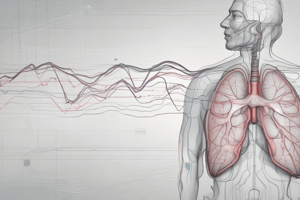Podcast
Questions and Answers
What should be done when a new symptom or sign appears during routine monitoring?
What should be done when a new symptom or sign appears during routine monitoring?
- Begin searching for the possible cause. (correct)
- Prepare to treat it as a serious condition.
- Ignore it unless it persists.
- Consult with a specialist immediately.
When should a search for a possible cause of new findings begin?
When should a search for a possible cause of new findings begin?
- Immediately after a new symptom appears. (correct)
- Only if the new finding is severe.
- Following routine monitoring.
- Once a specialist has been consulted.
What is the suggested course of action for monitoring findings?
What is the suggested course of action for monitoring findings?
- Discuss with a patient what the symptoms mean.
- Document the findings without action.
- Begin an immediate search for the causative factors. (correct)
- Only investigate if multiple symptoms appear.
What is a critical response to newly emerged symptoms during routine health checks?
What is a critical response to newly emerged symptoms during routine health checks?
Why is it important to address new signs or symptoms promptly?
Why is it important to address new signs or symptoms promptly?
What is a potential cause for unilateral decrease in chest wall expansion?
What is a potential cause for unilateral decrease in chest wall expansion?
Which of the following indicates a need to monitor asynchrony with the ventilator?
Which of the following indicates a need to monitor asynchrony with the ventilator?
What condition can cause splinting of the chest wall?
What condition can cause splinting of the chest wall?
Which of the following is a potential result of obstruction of a major bronchus?
Which of the following is a potential result of obstruction of a major bronchus?
What might frequent monitoring of a patient indicate when asynchrony with the ventilator is evident?
What might frequent monitoring of a patient indicate when asynchrony with the ventilator is evident?
What does a prompt improvement in the patient indicate?
What does a prompt improvement in the patient indicate?
If a patient does not improve after intervention, what should be the next step?
If a patient does not improve after intervention, what should be the next step?
What is the main focus of management if a patient shows no signs of improvement?
What is the main focus of management if a patient shows no signs of improvement?
Which of the following could NOT be considered a reason for a patient's lack of improvement?
Which of the following could NOT be considered a reason for a patient's lack of improvement?
If the source of the problem is identified as the ventilator, what is the likely next step?
If the source of the problem is identified as the ventilator, what is the likely next step?
What is the recommended frequency for monitoring blood pressure?
What is the recommended frequency for monitoring blood pressure?
Which of the following is NOT a cause of hypotension?
Which of the following is NOT a cause of hypotension?
Which type of medications are known to contribute to hypotension?
Which type of medications are known to contribute to hypotension?
What effect does high external or internal PEEP have on blood pressure?
What effect does high external or internal PEEP have on blood pressure?
Which of the following conditions does NOT typically lead to hypotension?
Which of the following conditions does NOT typically lead to hypotension?
What is the expected capillary refill time after a 5-second compression of the nail bed?
What is the expected capillary refill time after a 5-second compression of the nail bed?
When should End tidal CO2 be monitored in patients?
When should End tidal CO2 be monitored in patients?
Under which condition is Central Venous Pressure (CVP) monitoring required hourly?
Under which condition is Central Venous Pressure (CVP) monitoring required hourly?
What should happen to the pink color in the nail bed after compression?
What should happen to the pink color in the nail bed after compression?
What does a capillary refill time longer than 3 seconds potentially indicate?
What does a capillary refill time longer than 3 seconds potentially indicate?
What might lead to copious, thin secretions in a patient?
What might lead to copious, thin secretions in a patient?
How often should breath sounds be monitored in a physical examination?
How often should breath sounds be monitored in a physical examination?
What should be checked to assess the condition of secretions?
What should be checked to assess the condition of secretions?
If ventilator tubing contains fluid, what action should be taken?
If ventilator tubing contains fluid, what action should be taken?
What is an appropriate response to an increase in humidity in a patient using a ventilator?
What is an appropriate response to an increase in humidity in a patient using a ventilator?
Flashcards
New symptom appearance
New symptom appearance
A new symptom, sign, or finding during routine monitoring.
Cause search
Cause search
Immediately investigate the possible reason for a new finding.
Routine monitoring
Routine monitoring
Regular check that tracks health status.
Symptom
Symptom
Signup and view all the flashcards
Sign
Sign
Signup and view all the flashcards
Unilateral chest expansion decrease
Unilateral chest expansion decrease
Signup and view all the flashcards
Intubation of right main stem bronchus
Intubation of right main stem bronchus
Signup and view all the flashcards
Asynchronous ventilation
Asynchronous ventilation
Signup and view all the flashcards
Atelectasis
Atelectasis
Signup and view all the flashcards
Consolidation
Consolidation
Signup and view all the flashcards
Ventilator/External Circuit Problem
Ventilator/External Circuit Problem
Signup and view all the flashcards
ETT or Patient Problem
ETT or Patient Problem
Signup and view all the flashcards
Troubleshooting Steps
Troubleshooting Steps
Signup and view all the flashcards
Patient Improvement
Patient Improvement
Signup and view all the flashcards
Patient Deterioration
Patient Deterioration
Signup and view all the flashcards
Blood pressure monitoring
Blood pressure monitoring
Signup and view all the flashcards
Hypotension
Hypotension
Signup and view all the flashcards
Causes of hypotension
Causes of hypotension
Signup and view all the flashcards
Decreased intravascular volume
Decreased intravascular volume
Signup and view all the flashcards
High PEEP
High PEEP
Signup and view all the flashcards
Copious secretions
Copious secretions
Signup and view all the flashcards
Secretion colour observation
Secretion colour observation
Signup and view all the flashcards
Breath sounds monitoring
Breath sounds monitoring
Signup and view all the flashcards
Frequent breath sounds monitoring
Frequent breath sounds monitoring
Signup and view all the flashcards
Ventilator tubing repositioning
Ventilator tubing repositioning
Signup and view all the flashcards
End Tidal CO2
End Tidal CO2
Signup and view all the flashcards
Hourly CO2 Monitoring
Hourly CO2 Monitoring
Signup and view all the flashcards
Central Venous Pressure (CVP)
Central Venous Pressure (CVP)
Signup and view all the flashcards
Hourly CVP Monitoring
Hourly CVP Monitoring
Signup and view all the flashcards
Capillary Refill Time
Capillary Refill Time
Signup and view all the flashcards
Study Notes
Patient Monitoring in ICU
- Monitoring in medicine involves observing a disease, condition, or medical parameters over time.
- Monitoring can be continuous (e.g., vital signs using a bedside monitor) or repeated (e.g., blood glucose monitoring).
- Monitoring aims to detect problems early and manage them.
- Important parameters are monitored regularly and recorded.
Introduction
- Monitoring initiates when a new symptom or finding arises.
- Crucial parameters for ICU monitoring include cardiac and hemodynamic function, respiratory status, blood glucose, body temperature, renal function, and nutritional status.
Patient Behaviors
- Monitor for anxiety, fear, restlessness, and agitation, also patient's response to the environment and medical devices.
- Assess comfort and use sedatives when needed.
- Check Pao2 and Spo2, and evaluate the patient-ventilator system.
- Check for and manage pain.
- Use the Glasgow Coma Scale (GCS) to assess alertness/consciousness levels.
- Evaluate perfusion to the brain by checking blood pressure and looking for acute events like strokes.
- Monitor ABGs if PaCO2 increases.
- Note and manage medication use.
- Track sleep adequacy.
Patient Behaviors (continued)
- Monitor for twitching, convulsions, and tetany, especially if anticonvulsant levels are low in patients with known seizures.
- Check for PaCO2 changes with rising pH.
- Observe for breathlessness, anxiety, decreased oxygen (↓PaO2), decreased ventilation, and pneumothorax.
Inspection
- Evaluate chest wall movements and look for paradoxical chest movement, inward chest movement during inspiration, or asynchronous chest and abdominal movement.
- Observe for unilateral decrease in chest wall expansion. This could be due to bronchus intubation, pain, air, blood, or fluid in the pleural cavity, atelectasis, or consolidation.
- Look for airway obstruction at the endotracheal tube (ETT) level.
- Assess for in-line continuous nebulization and monitor for secretions.
- Check for fluid accumulation in the ventilator circuit.
- Inspect for inappropriate ventilator settings (flow rate, I:E ratio, FiO2). Watch out for leaks in the system at ETT levels or the circuit itself.
- Observe for pneumothorax by looking for decreased oxygen levels (↓PaO2) and increased carbon dioxide levels (↑PaCO2). If no cause is found, disconnect from the ventilator and use manual ventilation with 100% oxygen.
Vital Signs
- Blood Pressure: Monitor hourly. Hypotension may indicate decreased intravascular volume, high external/internal PEEP, cardiac failure, or certain medications (sedatives and vasodilators). Check drainage systems and for IV site leaks. Hypertension may be due to anxiety, inadequate sedation, high carbon dioxide (↑PaCO2), or medications like vasopressors
- Heart Rate and Rhythm: Monitor frequently (hourly) for new arrhythmias or changes (tachycardia or bradycardia). Evaluate for anxiety, sedation, drug use, low oxygen/high carbon dioxide levels, and low intravascular volume. Check other hemodynamic parameters to evaluate perfusion.
- Urinary Output: Monitor and calculate hourly. Decreased output points to low kidney perfusion, low intravascular volume, and acute renal failure. Increased output (over 100 mL/hr) indicates possible overhydration. Normal ranges exist for adults and children
- Temperature: Monitor every 4-8 hours. Fever could be due to overheating humidifiers, atelectasis, infection, and high metabolic rates. Lower temperatures might be seen in the elderly. Observe if the axillary temperature is lower, or if the rectal temperature is higher than the oral temperature.
- Respiratory Rate: Monitor every 1-4 hours for changes related to ventilator settings, metabolic needs (anxiety, stress, infection, edema), low oxygen (↓PaO2), and high carbon dioxide (↑PaCO2) levels. Note use/potential effect of medications (sedatives, narcotics, anesthetics). Watch out for weaning complications and raised intracranial pressure
Physical Examination
- Breath Sounds: Monitor hourly or every 1-4 hours. Listen for unilateral decreased sounds, suggesting ETT blockage or fluid in the pleural space, blocked ETT, or issues like pneumonia. Look for late inspiratory crackles, which point to atelectasis or restrictive lung issues. Also check for decreased or absent breath sounds accompanied by mediastinal shift, which is a possible sign of tension pneumothorax. This is especially important in patients who are difficult to ventilate during CPR or those who worsen during ventilation.
- Air Leaks: Consistently inspect ETT and its cuff for leaks (hourly or every 1–2 hours) as this can lead to deflated/ruptured cuffs or ETT positioning above the vocal chords.
- Airway Secretions: Regularly check and evaluate airway secretions (with each suction). Thick secretions may indicate low humidity levels, while copious, thin secretions could suggest infection or fluid drainage into the trachea.
Lab Investigations
- Arterial Blood Gas (ABG): Evaluate with changes in ventilator settings or unexplained changes in the patient's condition.
- Serum Electrolytes: Daily or every other day.
- Blood Urea and Serum Creatinine: Twice weekly or Daily if needed.
- Cultures: As needed based on the patient's condition.
Studying That Suits You
Use AI to generate personalized quizzes and flashcards to suit your learning preferences.



